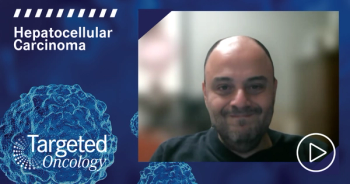
Richard Finn, MD: Next Steps for a uHCC Patient with Progressive Disease
What are the most important factors to consider in determining the next steps for this patient with progressive disease?
So this case highlights some important points in the management of patients with advanced hepatocellular carcinoma. This is a patient who has a long history of substance abuse, has developed cirrhosis in that context, and, as we know, regardless of the cause of cirrhosis, these patients are at risk of developing liver cancer. His cancer at presentation was advanced. It was unresectable, largely because he had extrahepatic disease and macrovascular invasion.
From the data we’re provided, his liver disease is fairly well compensated. His platelet count is high, it’s over 100,000, indicating he does not have significant portal hypertension and his Child-Pugh score is Child Class A, based on his bilirubin, albumen, INR, and other clinical parameters. He’s discussed at a multidisciplinary tumor board, and local regional therapy is recommended, specifically a chemoembolization and he has two of those procedures done. I think right away there are some questions raised about the choice of chemoembolization for this patient.
This patient, by the Barcelona staging system, has Barcelona stage C. They have macrovascular invasion and extrahepatic spread. One of these are markers for patients who do not benefit from local regional therapy, and, from the beginning, I think the guidelines and the data would suggest that this is appropriate patient for systemic treatment. Needless to say, the patient undergoes chemoembolization, has some response by RECIST criteria that is measuring the longest diameter of the tumor burden and eventually has progression.
CASE 2 : Unresectable Hepatocellular carcinoma (uHCC)
Richard G is a 64-year-old Caucasian night club owner from New Orleans, Louisiana with a history of alcohol and substance abuse, and alcohol-induced cirrhosis.
In April of 2012 the patient was diagnosed with unresectable hepatocellular carcinoma (uHCC), with a 4.6 x 4.3 cm mass detected in segment 6 of cirrhotic liver and evidence of macroscopic vascular invasion and extrahepatic spread to regional lymph nodes
TACE was recommended by the multidisciplinary team and the patient underwent a total of 2 TACE procedures, with a partial response observed (30% decrease in sum of greatest unidimensional diameters of target lesions compared to baseline) by RECIST criteria
In July 2013, follow up laboratory values were:
Albumin: 3.9 g/dL;
Bilirubin: 0.7 mg/dL
Alpha fetoprotein: 53.2 ng/mL
Platelets: 179,000
AST: 370 IU/mL
ALT: 189 IU/mL
The patient is classified as Child Pugh Class A at the current visit, with, with a MELD score of 10, and the patients ECOG performance status is 1
Contrast-enhanced MRI showed disease progression, with increases observed in diameter of multiple target lesions








































